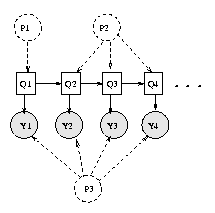


If it's happily barking, it's probably full. However, you can infer it from whether the dog whines. Given this system, you cannot see when the dog is hungry and when it is not. You know, however, that after it ate and became full, it will become hungry again after some time (depending on how much it ate last, but you don't know that so it might as well be random) and when it is hungry, it will eventually run inside and eat (sometimes it will sit outside out of laziness despite being hungry). You can't ask the dog if it's hungry, and you can't look inside its stomach, so the state is hidden from you (since you only glance outside, at the dog, briefly each day you can't keep track of when it runs inside to eat or and how much it ate if so). The dog may be hungry or full, this is the dog's state.

For example, suppose your neighbor has a dog. The transition matrix is simply the list of probabilities that one state will go to another.Ī hidden Markov model assumes you can't actually see what the state of the system is (it's hidden).


 0 kommentar(er)
0 kommentar(er)
